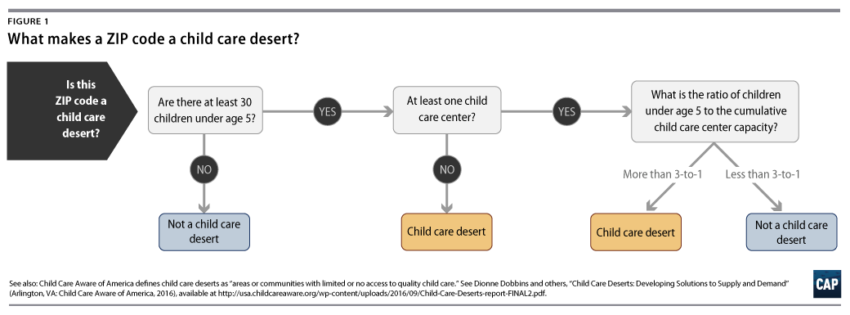
Share On Social!
Although research has shown the many health, social and emotional, and cognitive benefits of quality early child care and education, Latinos have the lowest participation in these programs.
Why?
Child care deserts may be the answer.
Although affordability, work schedules, and waiting lists are also factors, location is often the first major consideration for families.
Center for American Progress looked into the location of child care centers across eight states, which accounts for 20% of the population under age five.
The authors define child care desert as a ZIP code with at least 30 children under the age of five and either no child care centers so few centers that there are more than three times as many children under age 5 as there are spaces in centers. See image.
They found that 48% of the nearly 7,000 ZIP codes are child care deserts, meaning that 42% of children under five live in child care deserts.
In addition to a geographic analysis, the authors also conducted an economic analysis by low, moderate and high poverty, and a demographic analysis by race and ethnicity.
High-poverty child care deserts are more common in Hispanic communities, and urban child care deserts have three times the percentage of Hispanic residents as nondesert areas.
An increase in the percentage of Hispanic residents is associated with a large increase in the likelihood that a ZIP code will be a child care desert.
The availability of child care centers is in a state of crisis for Latino families. More information about families’ proximity to child care programs can inform local, state and federal efforts to increase access to early childhood programs.
The authors conclude that the US needs comprehensive child care reform to build the supply of high-quality early care centers and to make child care more affordable for families.
Share on Facebook or Twitter
High-poverty child care deserts are more common in Hispanic communities. #SaludChild #ECE
48% of the nearly 7,000 ZIP codes in 8 states are child care deserts. #SaludChild #ECE #ZIPMatters
The availability of child care centers is in a state of crisis for Latino families. #SaludChild #ECE
Nearly one million children in suburban areas across the eight states live in child care deserts. #SaludChild #ECE
60% of Hispanic Coloradans live in child care deserts compared to only 40% of white Coloradans. #SaludChild #ECE
85% of Hispanic Illinoisans live in child care deserts compared to 60% of white & black Illinoisans. #SaludChild #ECE #ZIPMatters
51% of Hispanic Marylanders live in child care deserts compared to only 31% of white Marylanders. #SaludChild #ECE
By The Numbers
84
percent
of Latino parents support public funding for afterschool programs



